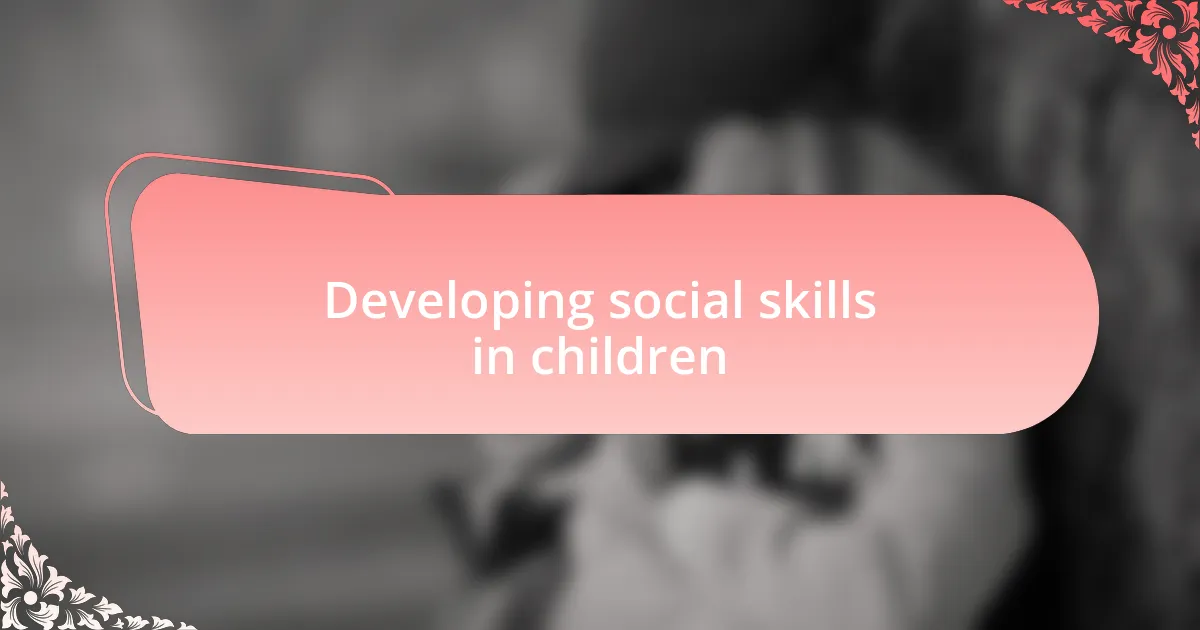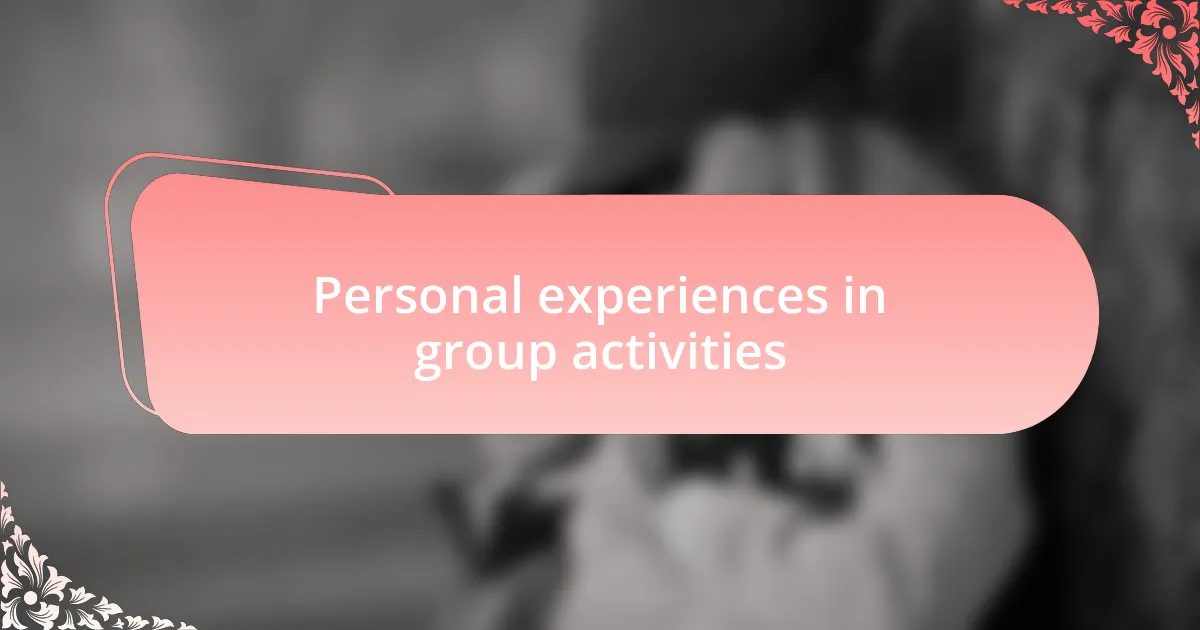Key takeaways:
- Group activities improve children’s emotional well-being, social skills, and promote healthy habits through shared experiences.
- Encouraging responsibility and structured reflection in group settings enhances participation and fosters critical thinking.
- Creating a supportive environment through trust, acknowledgment, and open communication is crucial for children’s growth in group activities.
- Personal experiences in group activities can lead to creativity, connection, and a sense of belonging among children.

Understanding group activities benefits
Engaging in group activities can be tremendously rewarding, especially when it comes to child health support. I remember the joy on my own child’s face during a community garden project. It wasn’t just about planting seeds; it was about cultivating friendships and learning to work together towards common goals.
From my perspective, group activities foster a sense of belonging that can significantly impact a child’s emotional well-being. Have you ever noticed how children often thrive when they’re part of a team? I’ve seen kids develop empathy and social skills as they navigate both victories and challenges together, enhancing their overall developmental experience.
Another benefit I’ve observed is the way these activities encourage healthy habits. For instance, I watched my child discover a love for physical exercise during a group sports event. This not only helped boost their confidence but also instilled a sense of discipline. Isn’t it incredible how these shared experiences can lay the foundation for lifelong healthy habits?

Developing social skills in children
Participation in group activities plays a pivotal role in developing social skills in children. I recall a time when my child joined a local theater group. Watching them step onto the stage for the first time, I was struck by how much their confidence blossomed as they collaborated with peers, sharing ideas and learning to communicate effectively. Isn’t it fascinating how children can find their voices among others?
Through group activities, I’ve seen children learn to navigate various social situations, from taking turns to resolving conflicts. My niece, for instance, faced challenges during a group art project. However, as they worked through disagreements over colors and designs, they not only created a beautiful mural but also forged stronger friendships. These moments illustrate how social skills develop through real-life experiences.
It’s also worth noting the role of emotional intelligence in these interactions. I once observed a playdate where my child comforted a friend who had fallen. This simple act revealed a growing ability to empathize and recognize others’ feelings. When children engage deeply in group activities, they’re often learning the complexities of social dynamics that will serve them throughout their lives.

Strategies for effective group participation
Finding ways to encourage meaningful contributions in a group setting can truly enhance participation. I remember when my child joined a sports team and the coach emphasized each player’s role, ensuring that everyone felt important. Have you noticed how much more engaged children are when they understand how they fit into a bigger picture? This strategy fosters a sense of belonging and motivates them to share their ideas confidently.
In my experience, giving children responsibility within group activities can lead to remarkable outcomes. Once, during a community service project, I watched my daughter take charge of organizing supplies. To my surprise, she not only developed her leadership skills but also inspired her teammates to contribute more enthusiastically. Isn’t it fascinating how a little responsibility can ignite enthusiasm?
Lastly, I’ve found that implementing structured reflection after group activities offers invaluable lessons. Reflecting on experiences allows children to share their feelings and thought processes. After a school project, my son and his peers discussed what they enjoyed and what they could improve for next time. This practice not only strengthens their understanding but also cultivates essential skills like critical thinking and collaboration. How often do we allow space for such reflections? It makes a significant difference in their growth.

Creating a supportive group environment
Creating a supportive group environment hinges on fostering trust and open communication among participants. I recall a group workshop I facilitated where we began with an icebreaker activity. It was amazing to see how laughter and shared stories could break down barriers, allowing children to feel more comfortable expressing themselves. Have you ever noticed how a simple game can transform the dynamics in a group? It really sets the stage for collaboration.
In my journey, I’ve learned that acknowledging individual contributions is vital for a supportive atmosphere. During a recent arts and crafts session, I made it a point to highlight each child’s unique creation. The pride on their faces was undeniable! When children feel recognized, their willingness to engage with others grows. How often do we, as adults, overlook the power of a genuine compliment?
Additionally, creating a safe space where children can voice their thoughts without fear of judgment is paramount. I once participated in a discussion circle where we established ground rules for respect and openness. The atmosphere shifted significantly as children began to share their ideas more freely, often leading to deeper conversations. Isn’t it uplifting to see a child take a step back, reflect, and voice their opinions? That environment fosters growth and nurtures their emotional intelligence.

Personal experiences in group activities
Participating in group activities can be a transformative experience. I remember one time during a team-building exercise where we built a tower out of spaghetti and marshmallows. It was fascinating to watch the strategies unfold as kids collaborated, each one offering ideas and building on one another’s thoughts. Have you ever seen how teamwork can ignite creativity? In that moment, I felt the energy flow through the group, and it was evident that they were not just building a structure but also forging connections.
Another memorable instance was during a group storytelling session. Each child contributed a line to the narrative, and the plot took unexpected turns that had everyone giggling. I noticed how anticipation grew as they awaited the next contribution. It was like a tapestry woven from their imaginations! I asked them how it felt to be part of something larger, and the smiles on their faces spoke volumes. They realized that their voices mattered, which is such a powerful takeaway for anyone, especially children.
There was also a time when I facilitated a nature walk where kids shared their discoveries. Each leaf, bug, or rock became a topic of discussion. Their curiosity was infectious. I remember one child who pointed out a ladybug and sparked a conversation about insects. It was beautiful to see how a simple walk fostered connection and learning. How often do we overlook the wonders in our surroundings while rushing through our days? That experience reminded me of the importance of slowing down, observing, and truly engaging with each other.

Tips for enhancing group participation
Creating an inviting atmosphere is pivotal for enhancing group participation. I once organized a warm-up icebreaker where each child shared their favorite game. The energy in the room shifted instantly; laughter and excitement filled the air. Have you ever felt how sharing personal interests can break down barriers and foster camaraderie? Watching those kids connect over their shared passions was truly heartwarming.
In my experience, setting clear expectations from the outset can make a significant difference. During one art project, I explained the goals and encouraged each child to voice their ideas openly. When they understood their roles in the activity, collaboration flourished. I often find that when children have a clear understanding of what’s expected, it can ignite their enthusiasm and drive them to participate actively.
Incorporating varied activities can also cater to different comfort levels within the group. I remember adjusting a game to include both quieter and more boisterous children, ensuring everyone had a chance to shine. Maybe you’ve seen it happen too—some prefer to observe while others jump right in. By allowing space for every personality type, participation becomes a natural outcome. What’s more, these small adjustments can empower children to step out of their comfort zones, leading to delightful surprises in their engagement.